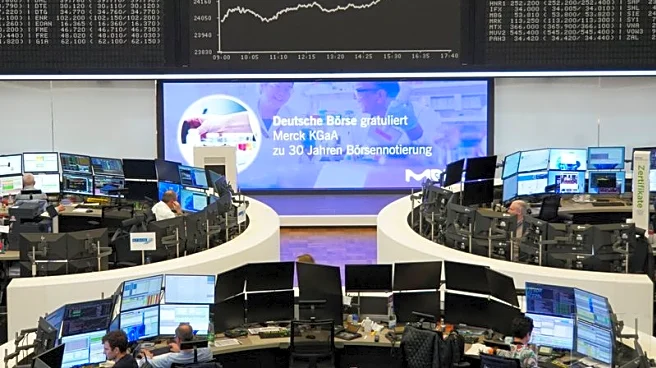What's Happening?
The U.S. dollar continued its upward trajectory, marking a fourth consecutive day of gains against a basket of currencies. This rise comes as the British pound fell following the release of inflation data
that undershot expectations. The pound's decline was attributed to the annual inflation rate in the UK holding steady at 3.8% in September, contrary to forecasts predicting a rise to 4%. Meanwhile, the yen showed slight improvement against the dollar, influenced by Japan's new Prime Minister Sanae Takaichi's plans for an economic stimulus package. Gold prices also experienced a downturn, easing to $4,026 per ounce after a significant drop the previous day.
Why It's Important?
The strengthening of the U.S. dollar has significant implications for global trade and economic stability. A stronger dollar can impact U.S. exports by making them more expensive on the international market, potentially affecting trade balances. The currency fluctuations also reflect broader economic uncertainties, including inflationary pressures and fiscal policies in major economies like the UK and Japan. Investors are closely monitoring these developments, as they could influence central bank decisions on interest rates, particularly in the U.S. and UK. The Federal Reserve's upcoming meeting and potential rate cuts are of particular interest, as they could further affect the dollar's value and global economic dynamics.
What's Next?
The Federal Reserve is expected to announce a decision on interest rates at its meeting on October 29, with a potential rate cut anticipated. This decision will be closely watched by investors and economists, as it could have a significant impact on the dollar's strength and broader economic conditions. Additionally, Japan's fiscal policy under Prime Minister Takaichi may lead to further currency fluctuations, depending on the size and scope of the proposed stimulus package. The Bank of England's future actions regarding interest rates will also be pivotal, as they navigate the current inflationary environment.
Beyond the Headlines
The ongoing currency fluctuations and inflation concerns highlight the interconnectedness of global economies and the challenges faced by policymakers in balancing growth and stability. The situation underscores the importance of coordinated fiscal and monetary policies, particularly in times of economic uncertainty. The potential for rate cuts and stimulus measures reflects the delicate balance central banks must maintain to support economic growth while managing inflationary pressures.













